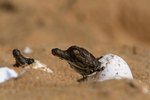Native to central Asia, Afghanistan, Pakistan and Iran, the Russian tortoise is a popular reptile pet because of his diminutive size. Males typically grow to around 6 inches in length, while females grow to a maximum of 8 inches. Because of the harsh climate in their native environment, Russian tortoises hibernate throughout each winter and are active for only a few months each year. They emerge each spring to forage for food and begin breeding.
Rough Sex
Mating typically takes place in the spring during the first few weeks after hibernation. Courtship begins when the male repeatedly circles the female, bobbing his head up and down. His behavior often becomes increasingly aggressive during the mating dance, during which he may butt the female's head, bite her forelegs and attempt to pull off her scales. Females can become anxious and stressed by the male's aggressive amorous advances and often attempt to escape. Once the male has mounted the female, his mouth opens wide and he begin emitting loud, high-pitched squeals.
Looking for Safe Ground
Within one month after fertilization, the female becomes increasingly restless as she searches for a suitable location to lay her eggs. Other behavioral signs that indicate pregnancy include constant leg wiggling, aggression toward other tortoises and frequent pacing. To ensure the safety of her eggs and future nest, she'll check and sniff the ground -- if the substrate is too dry or too wet, the nest might cave in on itself. The female will typically select a sunny location for her nest on well-drained soft soil, usually near rocks or shrub roots. In captivity, you'll need to provide your tortoise with an area of deep substrate for her to dig a nest.
Digging It
After the female has chosen the location for her nest, she'll begin digging several test nests, many of which she'll later abandon. Using her back legs to scoop out the soil, she'll carefully construct bell-shaped holes tseveral inches deep. The female stacks the removed soil in two separate piles to the sides of each hole. When she's nearly ready to lay her eggs, she'll begin pacing the perimeter of her nest area and often refuse to eat.
Bombs Away
When the female is satisfied with her nest, she'll suspend herself over the hole and spread her rear legs for support. Once she's in position, she'll begin pushing out the first egg. It might take many pushes before the egg is fully released. Once the egg is laid, the female will carefully push it out of the way with her legs to protect it from breaking while she lays another egg. Female tortoises typically lay two to three eggs per clutch. Once all her eggs are laid, she'll cover them with soil. Hatchlings typically appear within 80 to 100 days.





